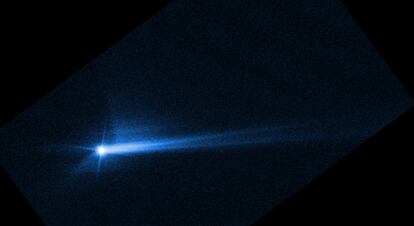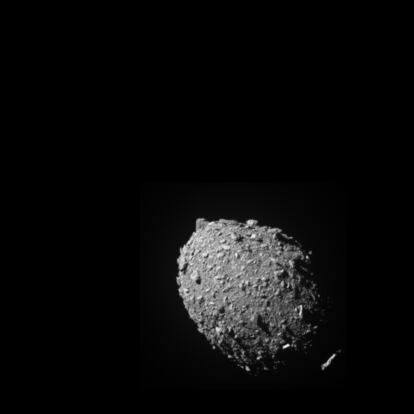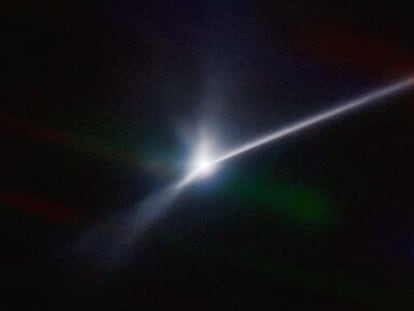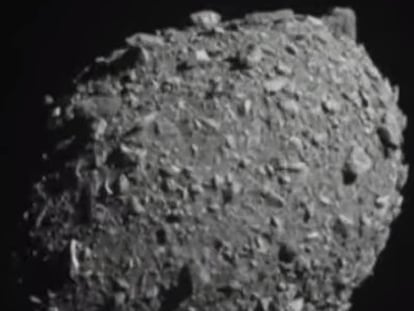NASA’s DART spacecraft successfully changes path of asteroid: What’s next?
The collision altered Dimorphos’ orbit around Didymos by 32 minutes in what the space agency describes as a ‘watershed moment for planetary defense and all of humanity’

Humanity’s first attempt to deflect an asteroid has been successful. That’s according to NASA, which confirmed Tuesday that its DART probe had changed the course of Dimorphos, an asteroid 11 million kilometers from Earth.
On September 27, NASA crashed the DART spacecraft into Dimorphos at a speed of around 22 km (14 miles) per hour. DART is the size of a refrigerator and weighs just 570 kilos, making it around 10 million times lighter than Dimorphos. The goal of the mission was to see whether the impact would change the course of Dimorphos, which orbits around another asteroid called Didymos.
The Didymos-Dimorphos binary asteroid system moves like clockwork. Until NASA’s intervention, Dimorphos made a complete revolution around Didymos in 11 hours and 55 minutes. But that has been successfully altered by the DART mission.
CONFIRMED: Analysis of data obtained over the past 2 weeks by the #DARTMission team shows impact with Dimorphos has successfully altered the asteroid’s orbit by 32 minutes - marking the 1st time humans have changed the orbit of a celestial object in space! https://t.co/MjmUAFwVSO pic.twitter.com/4Qiy1mC4gK
— NASA Asteroid Watch (@AsteroidWatch) October 11, 2022
“The investigation team has confirmed the spacecraft’s impact altered Dimorphos’ orbit around Didymos by 32 minutes,” said NASA Administrator Bill Nelson. “This is a watershed moment for planetary defense and all of humanity.”
The results have exceeded NASA’s expectations, which set the benchmark for success at 73 seconds or more, although it hoped to shorten the orbit by 10 minutes.
“This is something we can really be proud of as an international endeavor,” added Giorgio Saccoccia, the president of the Italian Space Agency, which made the LICIACube microsatellites that recorded the lead-up to and aftermath of the collision. “I think our planet can feel a bit more safe for the future.”
💫 Nuove immagini dell'impatto della #DARTmission sull'asteroide #Dimorphos, che variato la sua traiettoria attorno a #Didymos di oltre 30 minuti.
— LICIACube (@LICIACube) October 11, 2022
✨ New images of DART's impact on #Dimorphos asteroid, which caused a deviation of its trajectory around #Didymos by over 30 minutes. pic.twitter.com/MSJXOvlf6W
The DART mission, which stands for Double Asteroid Redirection Test, is NASA’s Planetary Defense Coordination Office’s first attempt to see whether it can avert an asteroid collision in the future. So far, researchers have identified more than 95% of all asteroids that are larger than one kilometer in diameter. These asteroids are capable of causing a planetary disaster similar to the extinction of the dinosaurs 66 million years ago.
Of greater concern are asteroids measuring 140 meters (460 feet) or more, of which only 40% have been identified. These have the same destructive power of a nuclear bomb, and could open a two-kilometer wide crater in the Earth. But given the so few have been recorded, there could be thousands of asteroids of this size on a collision course with Earth. The threat is so significant that in 2017 NASA approved $324 million in spending to make the DART mission a reality.

Aftermath of collision
DART’s collision with Dimorphos on September 27 was followed in near-real time from Earth. The last images captured by the spacecraft before impact revealed that the asteroid has an irregular and rocky surface. This seemed to indicate that the Dimorphos was what astrophysicists call a “rubble-pile” asteroid, meaning that the collision would release a cloud of dust. And that is exactly what happened.
Two days after the collision, the SOAR telescope in Chile detected that the crash had turned Dimorphos into something resembling a comet: the asteroid now had a 10,000-kilometer (6,213-mile) tail wagging in the solar wind.
René Duffard, a researcher from the Andalusian Astrophysics Institute in Spain, who collaborated on the DART mission, compared Dimorphos to a pool of rocks bounds together by gravity. “The impact released a seismic wave across the asteroid, which has acted more as if it were fluid than solid rock, which is why the enormous tail was formed,” he explained.
According to observations, the tail is made up of dust, and unlike actual comet tails, contains no traces of water. DART program scientist Tom Statler added on Tuesday that the NASA would continue investigating the composition of the asteroid and the effects of the impact.
The success of the DART mission is the first step in creating a planetary defense system. The data collected by the spacecraft and the LICIACuba microsatellite, as well as telescopes on Earth, will help refine the models that simulate possible asteroid collisions.
In 2024, the European Space Agency will launch Hera, a €130 million space probe that will reach Didymos and what is left of Dimorphos in 2026 to perform a post-impact survey. It will also create a detailed three-dimensional reconstruction of the crater left by DART. The next step is creating a model that is able to determine what kind of spacecraft would be needed to divert a potentially hazardous asteroid depending on its size, mass and the time it will take to hit Earth.
In 2026, the United States is set to launch the Near-Earth Object Surveyor (NEO) space telescope, which will study asteroids and comets larger than 140 meters (460 feet). This instrument will have infrared vision which will allow it to detect objects that approach from the direction of the Sun, a feat that is difficult for conventional telescopes.
Tu suscripción se está usando en otro dispositivo
¿Quieres añadir otro usuario a tu suscripción?
Si continúas leyendo en este dispositivo, no se podrá leer en el otro.
FlechaTu suscripción se está usando en otro dispositivo y solo puedes acceder a EL PAÍS desde un dispositivo a la vez.
Si quieres compartir tu cuenta, cambia tu suscripción a la modalidad Premium, así podrás añadir otro usuario. Cada uno accederá con su propia cuenta de email, lo que os permitirá personalizar vuestra experiencia en EL PAÍS.
¿Tienes una suscripción de empresa? Accede aquí para contratar más cuentas.
En el caso de no saber quién está usando tu cuenta, te recomendamos cambiar tu contraseña aquí.
Si decides continuar compartiendo tu cuenta, este mensaje se mostrará en tu dispositivo y en el de la otra persona que está usando tu cuenta de forma indefinida, afectando a tu experiencia de lectura. Puedes consultar aquí los términos y condiciones de la suscripción digital.











































